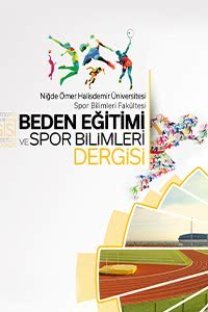Çocuklar için sporda hayal etme ölçeğinin Türkçeye uyarlanması: Bir geçerlik ve güvenirlik çalışması
The sport imagery questionnaire : A study of validity and reliabilit
___
- 1.Balcı A. (2001). Sosyal bilimlerde araştırma: Yöntem, teknik ve ilkeler. Ankara: Pegem Yayıncılık.
- 2.Bryman A. & Cramer D. (1997). Quantitative data Analysis with SPSS for windows: A guide for social scientists. New York: Routledge .
- 3.Büyüköztürk Ş, Akgün Ö, Kahveci Ö, & Demirel F. (2004b). Güdülenme ve Öğrenme Stratejileri Ölçeği’nin Türkçe formunun geçerlik ve güvenirlik çalışması. Kuram ve Uygulamada Eğitim Bilimleri, 4(2), 207-239.
- 4.Büyüköztürk Ş. (2002). Sosyal bilimler için veri analizi el kitabı. Ankara: Pegem A Yayıncılık
- 5.Büyüköztürk Ş. (2004a). Veri analizi el kitabı. Ankara: Pegem A Yayıncılık.
- 6.Callow N. Hardy L. & Hall C. (2001). The effect of a motivational general-mastery imagery intervention on the sport confidence of high-level badminton players. Research Quarterly for Exercise and Sport, 72, 389–400.
- 7.Cumming J. & Hall C. (2002). Athletes’ use of imagery in the off-season. The Sport Psychologist, 16, 160–172
- 8.Gregg M. & Hall C. (2006). The relationship of skill level and age to the use of imagery by golfers. Journal of Applied Sport Psychology, 18, 363–375.
- 9.Hall C, Mack D, Paivio A. & Hausenblas H. (1998). Imagery use by athletes: Development of the Sport Imagery Questionnaire. International Journal of Sport Psychology, 29, 73–89.
- 10.Hall RC, Munroe-Chandler KJ, Fishburne JG and Hall DN. (2009). The Sport Imagery Questionnaire for Children (SIQ-C). Measurement in Physical Education and Exercise Science, 13: 93–107
- 11.Hovardaoğlu S. ve Sezgin N. (1998). Eğitimde ve psikolojide ölçme standartları. Ankara: Türk Psikologlar Derneği ve ÖSYM yayını.
- 12.Hu LT. & Bnetler PM. (1999). Cutoff criteria for fit indexes in covariance structural analysis: Conventional criteria versus new alternatives. Structural Equation Modeling, 6, 1-55.
- 13.Karasar N. (1994). Bilimsel Araştırma Yöntemi. Ankara: 3A Araştırma Danışmanlık Limited.
- 14.Mills KD, Munroe KJ. & Hall CR. (2000). The relationship between imagery and self-efficacy in competitive athletes. Imagination, Cognition, and Personality, 20(1), 33–39.
- 15.Munroe K, Hall C, Simms S. & Weinberg R. (1998). The influence of type of sport and time of season on athletes’ use of imagery. The Sport Psychologist, 12, 440–449.
- 16.Munroe-Chandler KJ. & Hall CR. (2007). Psychological interventions in sport. In P. Crocker (Ed.), Introduction to sport psychology: A Canadian perspective (pp. 184–213). Toronto, ON: Pearson.
- 17.Osborne JW. & Costello AB. (2004). Sample size and subject to item ratio in principal components analysis. Practical Assessment, Research & Evaluation, 9(11).
- 18.Özgüven İE. (1994). Psikolojik testler. Ankara: Yeni Doğuş Matbaası
- 19.Paivio, A. (1985). Cognitive and motivational functions of imagery in human performance. Canadian Journal of Applied Sport Sciences, 10, 22–28.
- 20.Preacher KJ. & MacCallum RC. (2002). Exploratory factor analysis in behavior genetics research: Factor recovery with smallsample size. Behavior Genetics, 32 (2), 153-161.
- 21.Tavşancıl E. (2002). Tutumların Ölçülmesi ve SPSS ile Veri Analizi. Ankara: Nobel Yayın Dağıtım.
- 22.Tekin H. (1996). Eğitimde ölçme ve değerlendirme. Ankara: Yargı yayınları, no: 17.
- 23.Tezbaşaran AA. (1996). Likert tipi ölçek geliştirme kılavuzu. Ankara: Türk Psikologlar Derneği Yayınları.
- 24.Turgut MF. (1997). Eğitimde ölçme ve değerlendirme metodları. Ankara: Gül Yayınevi.
- 25.Turgut MF. ve Baykul Y. (1992). Ölçekleme teknikleri. Ankara: ÖSYM yayınları, no: 1992-1.
- 26.White A. & Hardy L. (1998). An in-depth analysis of the uses of imagery by high-level slalom canoeists and artistic gymnasts. The Sport Psychologist, 12, 387–403.
- ISSN: 1307-6477
- Yayın Aralığı: Yılda 3 Sayı
- Başlangıç: 2007
- Yayıncı: Niğde Üniversitesi Beden Eğitimi ve Spor Yüksek Okulu
The health-exercise/physical activity levels of the ice hockey players and coaches
Semiyha TUNCEL DOLAŞIR, Fehmi TUNCEL
Negatif duygusallığın stres üzerindeki etkisi: Faal futbol hakemleri üzerinde bir araştırma
Yusuf CAN, ÜLKÜ ÇOBAN, FİKRET SOYER
Beden eğitimi öğretmen adaylarının epistemolojik inançları ve benlik saygıları arasındaki ilişki
Murat ÖZŞAKER, Meliha CANPOLAT, LALE YILDIZ ÇAKIR
CENGİZ ARSLAN, Mehmet GÜLLÜ, Varol TUTAL
Çocuklar için sporda hayal etme ölçeğinin Türkçeye uyarlanması: Bir geçerlik ve güvenirlik çalışması
Haltercilerin kişilik özelliklerinin farklı değişkenlere göre incelenmesi
Ekstrem ve geleneksel spor katılımcıları arasında duygu arama farklılıklarının karşılaştırılması
HÜSEYİN KIRIMOĞLU, YUNUS YILDIRIM, Ali TEMİZ
